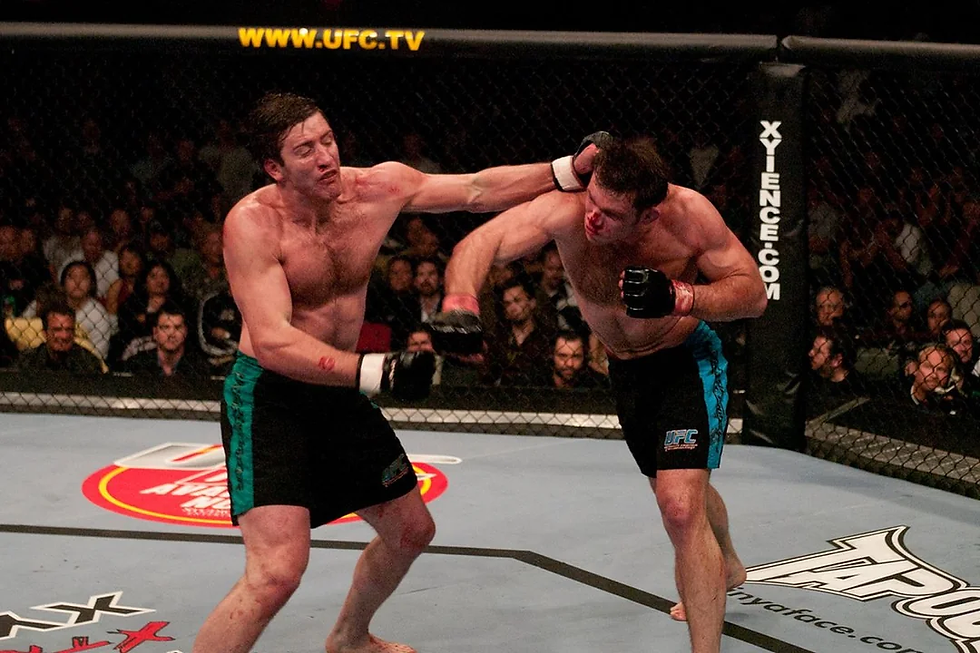The Fight That Saved the UFC: Stephan Bonnar vs. Forrest Griffin
- Combat Sight
- Nov 7, 2024
- 4 min read
How One Legendary Showdown Reshaped Mixed Martial Arts Forever

When Forrest Griffin and Stephan Bonnar entered the Octagon on April 9, 2005, they weren’t just fighting for a UFC contract; they were, unknowingly, fighting to secure the future of mixed martial arts in America. Their three-round showdown in the finale of The Ultimate Fighter (TUF) Season 1 marked a turning point, becoming known as "The Fight That Saved the UFC." This epic battle helped transform the struggling UFC into a globally recognized powerhouse and changed the way millions viewed MMA.
UFC’s Struggles and the Gamble on Reality TV
In the early 2000s, the UFC was at a crossroads. The Fertitta brothers and Dana White, who purchased the UFC in 2001 for just $2 million, faced mounting debts that exceeded $40 million. Despite their dedication to expanding the UFC’s audience, the sport was stigmatized by its violent reputation, making it hard to secure broadcasting deals. In a last-ditch effort to reach mainstream audiences, they launched The Ultimate Fighter, a reality show chronicling up-and-coming fighters training and living together. This show aired on Spike TV, which was willing to experiment with showcasing MMA without guarantees of success.
Many UFC staff saw TUF as a high-stakes bet. As UFC co-founder Lorenzo Fertitta said, “If this doesn’t work, we’re probably out of business”
UFC.Viewership for the series had been promising but not groundbreaking. Everything hinged on the season finale, and Bonnar vs. Griffin would ultimately determine the UFC’s future.
The Fight: A War of Heart and Grit
The Griffin-Bonnar fight began as a straightforward clash for a contract but quickly turned into something far greater. Fans were captivated as the two fighters pushed their limits, with both Griffin and Bonnar delivering blow after blow in a relentless back-and-forth. Griffin’s striking style met Bonnar’s grappling skills in a three-round brawl that left both fighters bloodied and exhausted but unbroken.
During the fight, the crowd’s energy in the Cox Pavilion exploded, and it was soon clear that this wasn’t just another match. The bout’s intensity drew in viewers from around the country, many of whom were watching MMA for the first time. As Bonnar recalled, “When everyone started stomping their feet...it felt like the whole place was shaking”.
The spectacle wasn’t lost on those watching at home, either, as it brought in 1.9 million viewers on Spike TV, which was unprecedented for MMA content at the time UFC.
Post-Fight Impact and UFC’s Transformation
Griffin emerged victorious in a unanimous decision, but Dana White awarded contracts to both fighters, recognizing the electrifying performance they had given. White often reflects on that decision as a turning point, stating, “It was one of the best decisions we ever made.” Immediately following the bout, White and Spike TV’s executives finalized a deal to renew The Ultimate Fighter for another season. The success of TUF 1 was undeniable, with the finale drawing more than twice the viewership the series had previously averaged.
This fight marked the beginning of the UFC’s rapid ascent in mainstream sports. Financially, the UFC saw immediate gains as it secured new sponsors and pay-per-view contracts, which had previously been challenging to secure due to MMA’s controversial reputation. The Ultimate Fighter finale demonstrated the sport’s potential for attracting a broad audience, helping change the perception of MMA from a fringe activity to a legitimate, respected sport.
The Lasting Legacy of Bonnar vs. Griffin
The Griffin-Bonnar bout shifted the public perception of MMA. Fans were captivated not just by the physicality but by the fighters’ resilience and mutual respect, helping debunk the notion that MMA was simply about brutality. Griffin, a former police officer, and Bonnar, a Purdue graduate in sports medicine, were relatable figures, and their performance demonstrated that MMA required intelligence, athleticism, and heart, which resonated deeply with viewers.
The significance of the fight goes beyond viewership metrics. The bout was inducted into the UFC Hall of Fame in 2013, and Dana White has repeatedly described it as “the most important fight in UFC history”.
Both Griffin and Bonnar became icons in MMA, with Griffin later capturing the UFC Light Heavyweight Championship and Bonnar remaining a fan favourite for his grit and fighting spirit.
How This Fight Changed MMA and UFC Forever
The Bonnar-Griffin fight had long-term effects on MMA in the United States. Over the next decade, the UFC expanded its footprint exponentially, broadcasting in over 150 countries and bringing MMA to the mainstream. Spike TV’s ratings surge for TUF allowed the UFC to negotiate more favourable television contracts, propelling the organization to the forefront of combat sports.
The fight also influenced the development of MMA as a sport, with more states moving to legalize and regulate it. By proving that MMA could draw large audiences and presenting fighters as relatable athletes rather than “human cockfighters,” the UFC gained momentum in securing more lucrative deals and fighting venues, such as Madison Square Garden in New York.
Today, the UFC is a global phenomenon, worth over $10 billion and boasting millions of fans around the world. This success traces directly back to one unforgettable night in April 2005. The Griffin-Bonnar showdown not only rescued the UFC from financial peril but also legitimized MMA as a sport that showcased athletic skill, mental toughness, and the kind of heart that captivated a worldwide audience.
As MMA’s popularity continues to soar, fans and fighters alike look back at the Bonnar vs. Griffin bout as a defining moment that exemplified the spirit of the sport. The fight lives on in the memory of fans, encapsulating the UFC’s journey from near-extinction to its position as a titan in global sports entertainment.





Commentaires